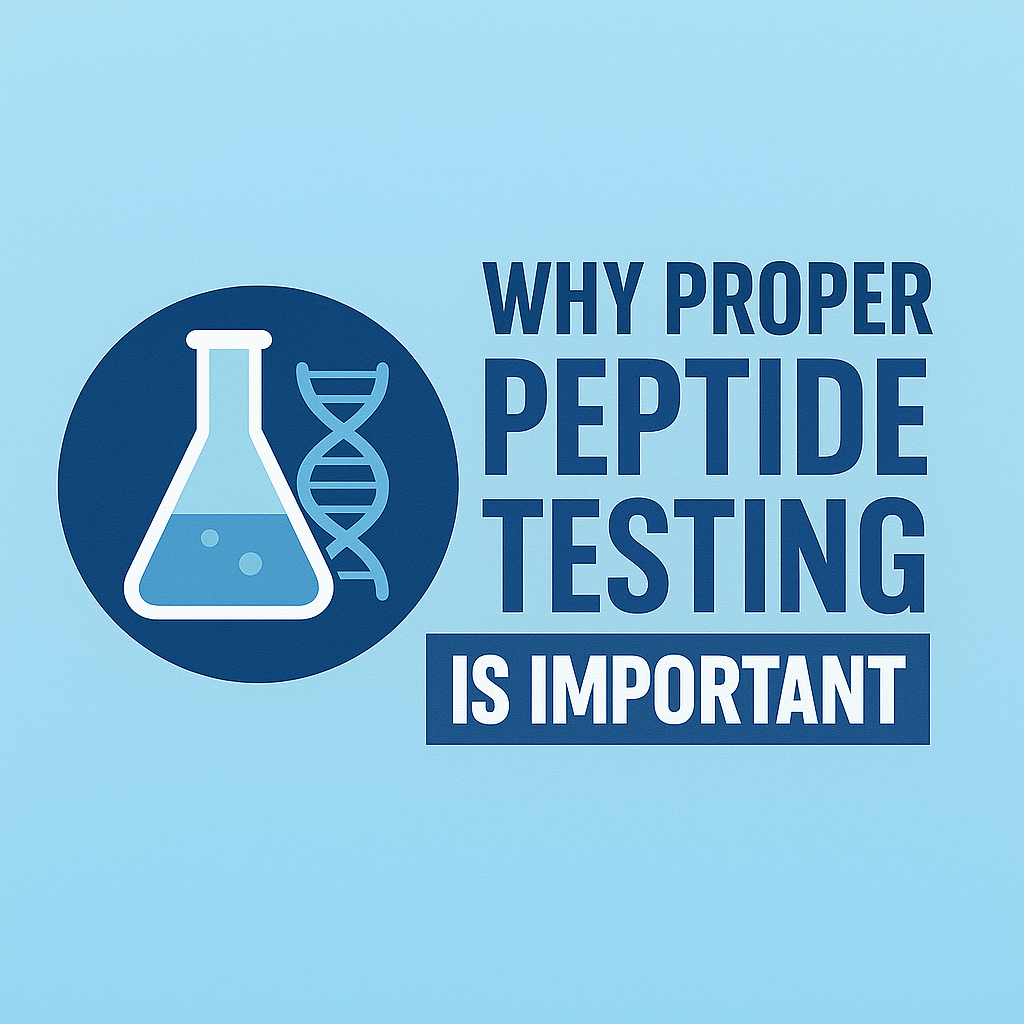
🧬 Understanding Peptide Testing
A Complete Beginner’s Guide to Why Testing Matters and What It Means
💡 Introduction: Why Testing Matters
When it comes to peptides, testing is everything. Peptides are complex biological molecules that must be handled and manufactured with precision. Proper testing ensures that what’s inside the vial is exactly what it’s supposed to be—clean, pure, and safe for laboratory research.
Unfortunately, many peptides on the market are made in poorly controlled environments or are not tested at all. This can lead to inaccurate results, inconsistent research, and wasted resources. Proper testing verifies that a peptide meets strict scientific standards before it ever leaves the lab.
Even though these products are for research use only and not intended for human consumption, quality testing protects the integrity of the research being done.
🔍 The Four Major Types of Peptide Testing
When a reputable manufacturer or supplier tests peptides, they usually include four key categories of analysis:
Net Peptide Content Testing
Purity Testing (HPLC Analysis)
Endotoxin Testing
Sterility Testing (coming soon for many labs)
Each test gives different information about the quality and reliability of the peptide.
🧪 1. Net Peptide Content Testing
Purpose: To measure how much actual peptide is in the vial.
When a peptide is lyophilized (freeze-dried), the final solid can contain trace amounts of water, salts, or other residues from the synthesis process. Net peptide content testing determines what percentage of the total weight is pure peptide versus other substances.
For example:
If a vial weighs 10 mg and the test shows 90% net peptide content, that means 9 mg is peptide and 1 mg is other material (like counter-ions or moisture).
This ensures researchers know the true dosage and can calculate accurate concentrations during reconstitution.
Why it matters:
Prevents inaccurate experimental results.
Ensures consistency between batches.
Confirms the peptide was synthesized and dried correctly.
⚗️ 2. Purity Testing (HPLC Analysis)
Purpose: To verify how pure the peptide is and to detect any unwanted byproducts.
HPLC stands for High-Performance Liquid Chromatography, a laboratory technique that separates compounds based on their chemical properties. When applied to peptides, HPLC produces a graph called a chromatogram that shows all the components found in the sample.
A properly made peptide should show one dominant peak on the HPLC graph, representing the correct molecule. Small additional peaks may indicate trace impurities, which are normal to some extent—but high-quality peptides generally test at ≥ 98% purity.
Why it matters:
Confirms the peptide sequence is correct.
Detects incomplete synthesis or contamination.
Ensures the research results will be accurate and repeatable.
🧫 3. Endotoxin Testing
Purpose: To check for the presence of bacterial toxins.
Endotoxins are toxic molecules found in the outer membrane of certain bacteria. Even a small amount can interfere with laboratory experiments or cellular studies.
Endotoxin testing uses a specialized assay (often called the LAL test) to detect and quantify any bacterial residues in the peptide. This ensures that the product is clean and suitable for scientific use.
Why it matters:
Protects biological cell cultures from contamination.
Confirms the product was handled in a sterile environment.
Provides confidence in data reliability for in-vitro research.
🧴 4. Sterility Testing (Coming Soon in Many Labs)
Purpose: To confirm that the product contains no living microorganisms such as bacteria, mold, or yeast.
Sterility testing involves incubating samples in growth media to see if any microorganisms develop. While peptides for research are not made for injection or human use, sterility testing demonstrates that the lab maintains high cleanliness standards and uses sterile handling processes.
Why it matters:
Shows strong manufacturing hygiene practices.
Reduces the chance of microbial interference in experiments.
Demonstrates a higher level of quality assurance to researchers and regulators.
🧴 4. Warning Signs
These are some deceptive practices that you should be looking out for and why.
Same Cap Colors across all products:
Many peptide companies claim it is for brand consistency, when in fact many do it so that they do not have to test every new batch. Many will go through several batches without re-testing each one by using this technique.
Same Cap Color and Batch Number:
Many peptide companies make agreements with the peptide manufactures to keep the same cap color across many batches to avoid re-testing costs.
Research Grade with No COA:
It doesn’t matter what grade a peptide seller wants to call a product, every peptide product needs to be tested and should have a COA. there only a couple of exceptions, once be an actual pharmaceutical grade like the South Koren brand Glutaone.
🧬 The Big Picture: What Testing Protects Against
| Problem Without Testing | What Can Go Wrong | How Testing Prevents It |
|---|---|---|
| Impure peptide synthesis | Wrong sequence or degraded peptide | HPLC Purity Analysis |
| Incorrect dosage | Misleading research results | Net Peptide Content |
| Bacterial contamination | Ruined cell culture or false data | Endotoxin Testing |
| Poor manufacturing hygiene | Microbial growth or product instability | Sterility Testing |
🧠 Final Takeaway
Proper peptide testing isn’t just a technical detail—it’s the foundation of trustworthy research.
A peptide that looks fine in the vial might still be impure, unstable, or contaminated if it hasn’t been tested. Testing ensures every batch meets scientific standards for:
Purity (no unwanted chemicals)
Identity (the correct amino acid sequence)
Safety (no bacterial toxins or contaminants)
Consistency (reliable results across experiments)
When choosing peptides, always look for suppliers who provide third-party test results such as HPLC purity analysis, endotoxin certificates, and net content verification. This transparency is what separates high-quality research materials from low-grade imitations.
- It is imperative that you know the products that you purchase for your research whether it is from Southern Aminos or another company!
